Toyota wanted to start the new millennium with a bang, so they brought us the 2.4L inline-4 2AZ-FE engine in 2000, replacing the outdated 2.2L 5S-FE engine, which had been around since 1980.
It should come as no surprise that the new 2AZ-FE packs a harder punch than its rather antiquated predecessor, but it isn’t exactly what we call a high-performance engine.
The 2AZ-FE is a compact and lightweight unit designed for optimum economy and efficiency. As good as it was, it did suffer from some serious issues, and by 2015, the writing was on the wall.
While it received some minor updates and modifications during its 12-year lifespan, the 2AZ-FE was eventually replaced by the 2AR-FE, an engine that’s superior in almost every way.
In this article, we’ll cover both the good and the bad parts of the Toyota 2AZ-FE, and provide you with all the information you need to know before buying a car with this engine.
2AZ-FE Specs
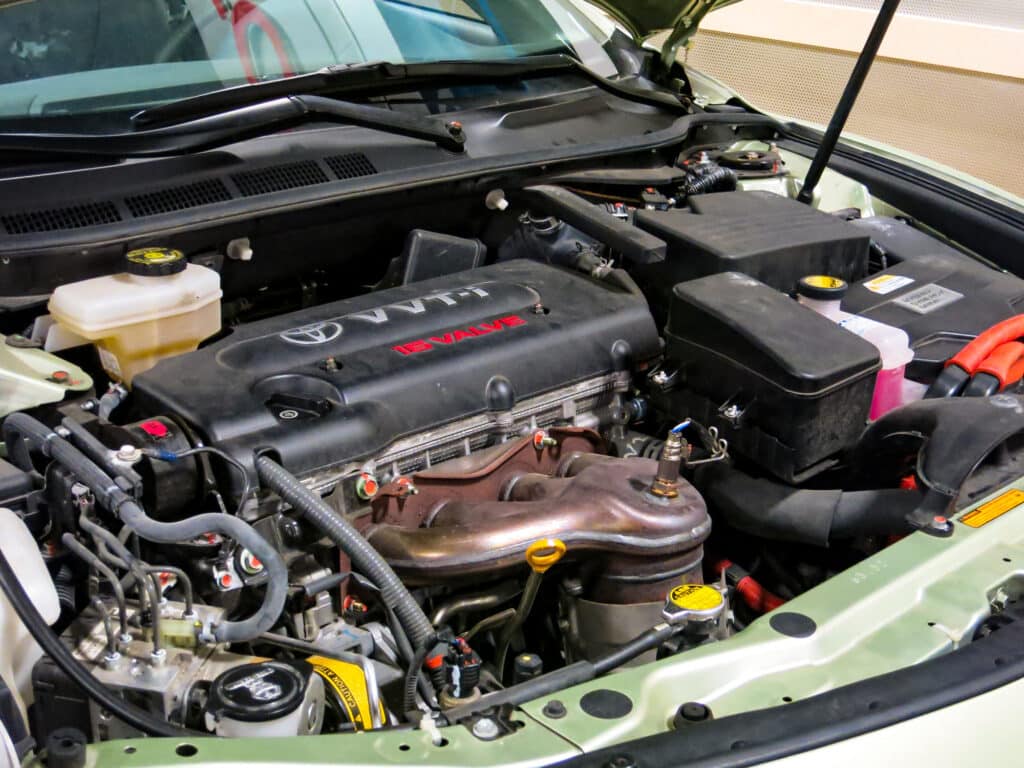
Engine code: 2AZ-FE
Production: 2000-2015, Toyota Motoring Manufacturing Kentucky, Kamigo and Shimoyama plants, Japan
Layout: Inline-4, DOHC, 16-valve
Displacement: 2.4L (2,362 cc)
Fuel system: Sequential MPFI
Cylinder bore: 88.5 mm (3.48″)
Piston stroke: 96 mm (3.78″)
Compression ratio: 9.6:1 and 9.8:1
Power: 145-177 hp
Torque: 162 lb-ft
Firing order: 1-3-4-2
As its name implies, the 2AZ-FE 2.4L unit is part of Toyota’s AZ engine family; it’s like a more advanced version of the 2.0L 1AZ-FE.
The two engines are very similar, with one of the main differences being a modified cylinder block due to the 2AZ-FE’s increased bore and stroke.
The 2AZ-FE engine uses an open-deck, midi-skirt aluminum engine block with cast iron cylinder liners, and it has an aluminum DOHC 16-valve cylinder head.
It was a fairly advanced engine at the time, featuring technology such as:
- Chain-driven cams
- Electronic throttle body
- Offset cylinder and crank centers
- Shimless lifters (not hydraulic)
- Slant-squish combustion chambers
- VVT-i continuously variable intake valve timing system
To minimize engine vibration, Toyota used 2 balancing shafts inside the crankcase, ensuring minimal engine vibration.
Toyota also kept the engine compact, and it measures in at a mere 24.6” (626 mm) in length, 23.9” (608 mm) in width, and 26.8” (681 mm) in height.
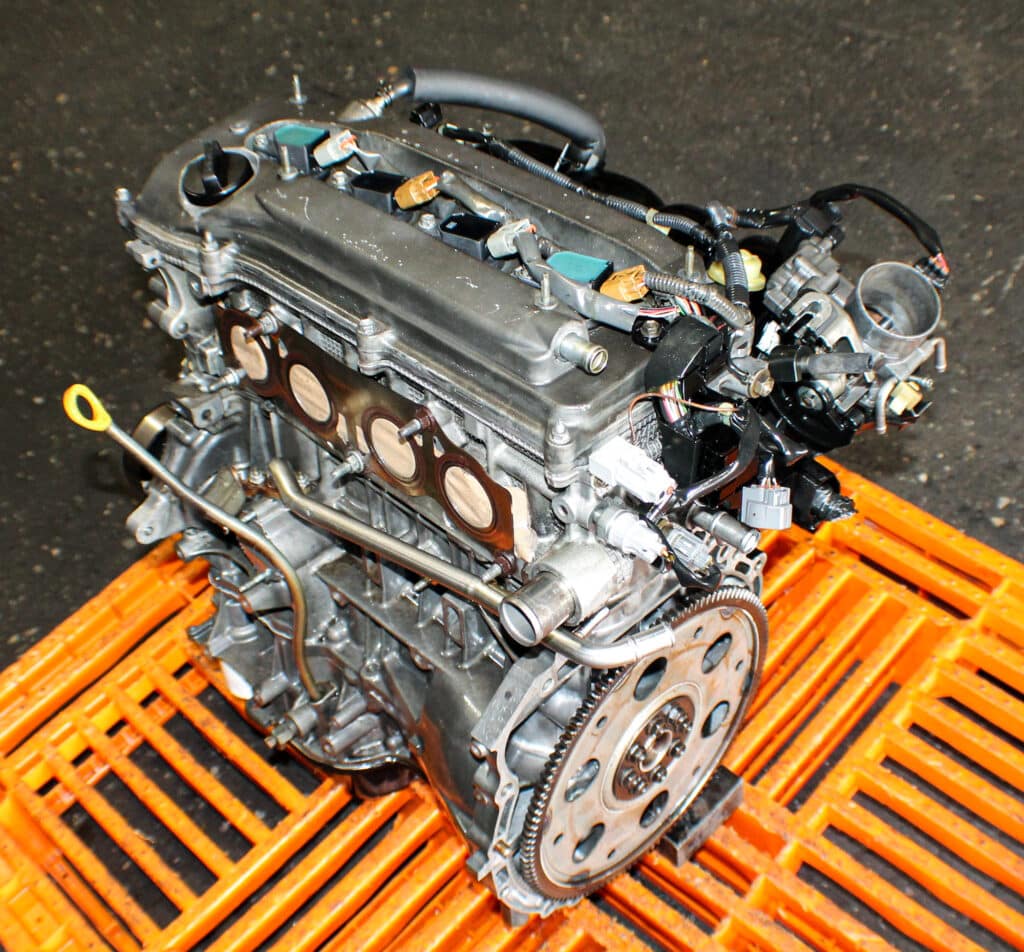
Using an aluminum block and head saved weight, but Toyota took weight savings one step further by making the valve cover from magnesium alloy, and as a result, the 2AZ-FE engine weighs in at a mere 305 lbs.
The early 2AZ-FE engines had a 9.6:1 compression ratio, which was then raised to 9.8:1 in 2008. Early engines produced 160 hp at 5,600 rpm and 162 lb-ft at 4,000 rpm.
The later models with increased compression also had some minor upgrades, including a more aggressive intake cam, increased rpm redline, and piston oil squirters, which resulted in more power.
The post-2008 engines were rated under the new SAE J1349 standard, which tends to produce more conservative numbers, so it’s difficult to do a direct comparison between the two.
However, the updated engines put down between 158 hp and 177 hp, depending on the model.
During its 12-year production run, millions of Toyota and Scion vehicles were sold with the 2AZ engine.
Its compact size, lightness, power, and fuel-efficient nature meant it was the perfect match for their small and medium-sized cars and crossovers, such as the Camry, RAV4, and Scion tC.
Toyota built its 2AZ-FE engines at various plants around the world. For the North American market, engines were built at the Toyota Motoring Manufacturing Kentucky plant.
The Japanese market used engines built at the Kamigo and Shimoyama plants in Japan, and there were even Australian and Chinese plants building 2AZ units.
The 2AZ-FE engine was extremely popular and found its way under the hood of many different models. It wasn’t used exclusively in Toyotas either. Here’s a list of cars that were available with the 2.4L Toyota unit.
- Alphard
- Avensis
- Blade
- Camry
- Camry Solara
- Corolla XRS
- Estima
- Harrier
- Highlander
- Ipsum
- Kluger
- Matrix S (USA)/XR (CA)/XRS
- Previa
- Rav4
- Tarago
- Pontiac Vibe
- Scion xB
- Scion tC
- Toyota Mark X Zio
As popular as the 2AZ-FE was, there’s no hiding that it did suffer from some problems.
These issues eventually culminated in class action lawsuits, and Toyota has issued an extended warranty notification for North American vehicles.
Toyota 2AZ-FE Engine Problems
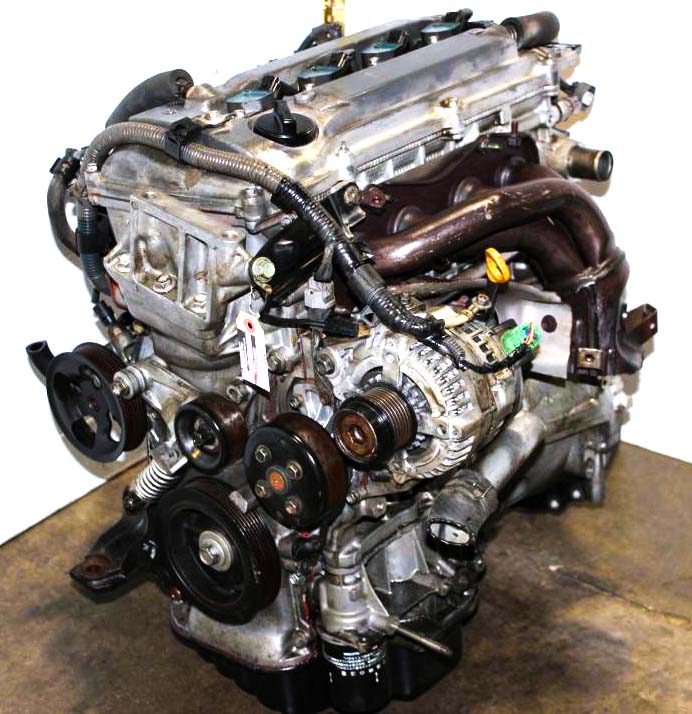
Unfortunately, the Toyota 2AZ-FE engine problems have earned it a somewhat bad reputation.
We’re talking about the dreaded oil-burning issue, which is probably the main reason why you’re reading this article.
Some enthusiasts would argue its poor reputation is undeserved, as the Toyota 2AZ-FE is still a relatively reliable Toyota engine.
Granted, owners will have to spend money topping up the oil more frequently, but the excessive oil consumption doesn’t seem to affect its longevity and reliability.
As with any other engine, oil leaks, worn-out components, and various other issues may occur, but those are mostly related to age and a lack of proper maintenance.
As long as you follow Toyota’s recommended service intervals, use quality oils, and fix any issues as soon as they crop up, the 2AZ-FE engine will stay reliable.
There are multiple stories online about owners driving their 2AZ-FE-powered cars for more than 300,000 miles without any serious problems, so we wouldn’t be too concerned about buying a used car with this engine.
Oil Burning

This is easily the main problem with this engine. The 2AZ-FE’s oil-burning problems have led to lawsuits, and while Toyota never issued a recall on cars fitted with the 2.4L unit, they have acknowledged the problem.
The engines involved in the lawsuit were the units installed in the 2007-2009 Camry and the 2006-2009 RAV4.
The most likely culprit is the piston ring design, but some people claim it might be caused by a head gasket problem, although there’s not a lot of evidence behind those claims.
What happens is that some oil makes its way past the piston rings through a gap that’s too large, and then it burns off in the combustion chamber.
The 2.4L Toyota engine certainly isn’t the only engine to experience this, and the problem is not known to reduce the engine’s life expectancy.
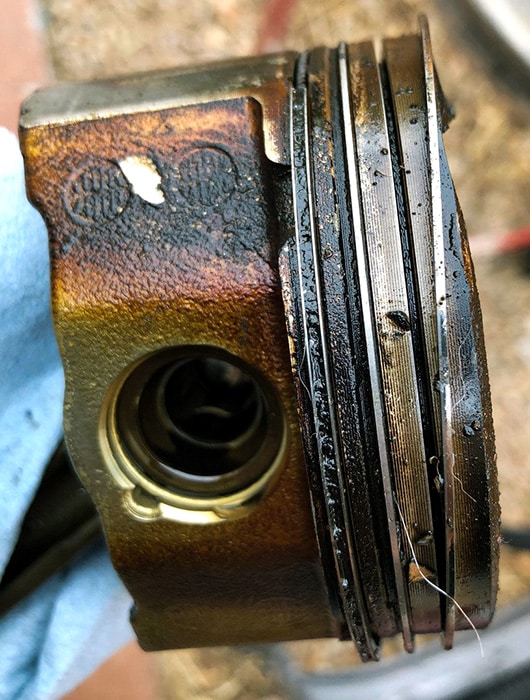
Toyota issued a technical service bulletin in 2011 and offered a solution in the form of a free oil consumption test to determine if an engine is affected.
In 2015, they extended the warranty, but this only applies to cars sold on the US market.
Engines that burn more than 1 U.S. quart of oil in 1,200 miles, have less than 150,000 miles, are less than 10 years old, and are located in the U.S. are covered by a Warranty Enhancement Program.
Approximately 1.7 million cars were eligible at the time they introduced this.
The oil-burning issue is known to start after 45,000 miles but is more likely to happen around the 70,000-mile mark.
Owners should check the oil levels regularly and top up whenever it’s needed. If the engine is running low on oil for extended periods, it can cause additional wear and tear, and even total failure.
As long as the 2.4L Toyota engine’s oil level is where it’s supposed to be, the increased oil consumption most likely won’t have a major negative effect on the engine’s life span.
Fixing the oil-burning problem requires replacing the piston rings, and while the parts themselves are affordable, this isn’t a quick and easy solution.
Even if you do decide to replace them, there’s no guarantee the problem will be fixed for good. It will most likely hold up for another 70,000+ miles.
However, there are some simple things you can do to potentially reduce the 2AZ-FE’s oil consumption issue.
Shorten the service intervals, change the oil more often, and use heavier oil weights, as it won’t get past the piston rings as easily.
Increasing the oil’s cold weight and using something like 5W30 or 10W30 may also be beneficial, as a hot engine should naturally have lower oil consumption.
Keep idling at a minimum, especially when the engine is cold. Finally, you can try to use some oil and fuel additives and see if that helps reduce oil consumption.
Some owners have reported reduced oil consumption when using additives, others say nothing changed, but it may be worth a shot.
Carbon Build-Up

Some potential buyers worry about the 2AZ engine’s carbon build-up issue, but in most cases, it’s nothing to worry about.
The carbon buildup problem is only relevant to one version of the 2AZ engine — the 2AZ-FSE, and it’s only found in some Toyota Avensis models.
Carbon build-up can be a sign of a lack of maintenance, but it also happens in cars that are never given a chance to stretch their legs a little. It’s caused by oil that gets into the intake ports and sticks to the walls and intake valves.
On port injection engines, carbon build-up is very rarely a problem as fuel is sprayed into the ports and the gasoline will clean off any deposits.
However, in direct injection engines, such as the 2AZ-FSE, fuel is sprayed directly into the cylinder, so the oil in the intake ports is allowed to harden and form carbon build-up. This can be remedied to an extent with the help of an oil catch can.
Telltale signs of carbon build-up include engine misfires, rough or uneven idle, stuttering and hesitation when accelerating, and a loss of power. It’s worth noting that these could also be symptoms of bad spark plugs.
Since the carbon takes years to gradually build up, you probably won’t even notice the power loss until it’s too late.
Giving it the occasional Italian tune-up will help to prevent carbon deposits from building up. If the damage is already done, then walnut blasting is probably the best way to get rid of carbon deposits.
It’s a fairly inexpensive method, and your car will be back to normal once it’s done.
Oil Leak
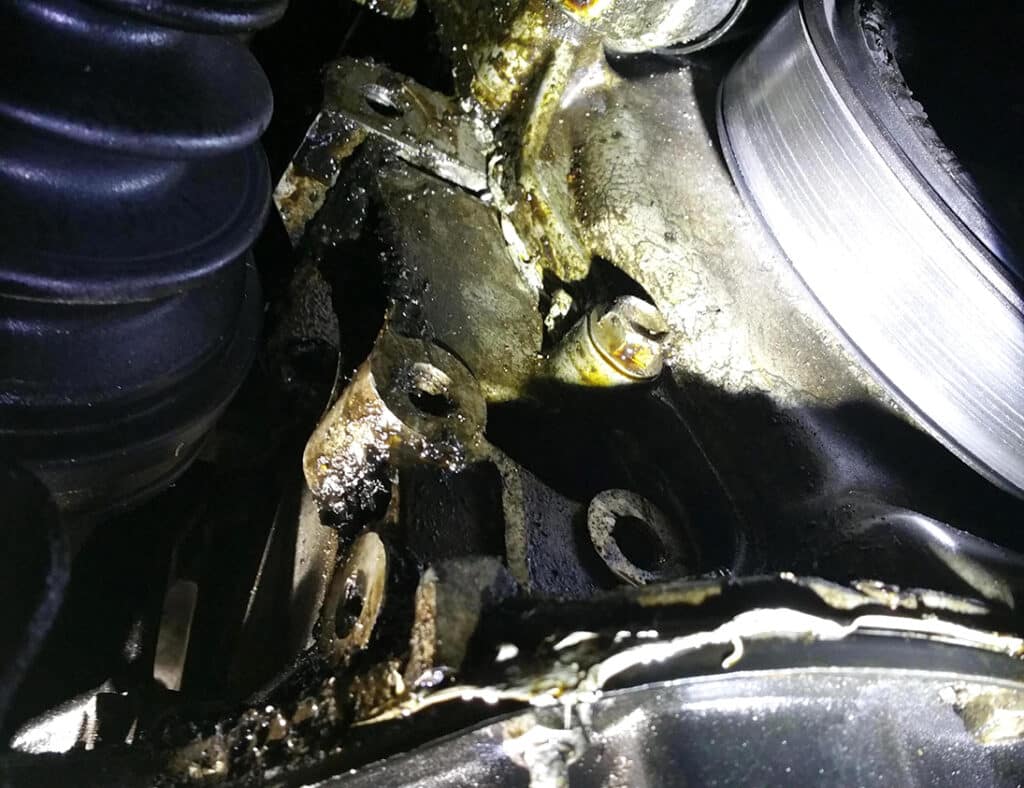
Any engine can develop oil leaks over time, so this issue isn’t necessarily unique to the 2.4L Toyota engine.
Oil leaks are usually something that comes with age, as gaskets, seals O-rings, hoses, and other rubber parts deteriorate, dry out, and harden, which eventually causes them to crack.
Unfortunately, the 2AZ isn’t getting any younger, so this is certainly an issue you’ll want to keep an eye out for and stay on top of.
We’ve already mentioned that the 2AZ engine does drink a fair bit of oil, and combined with oil leaks, this can potentially spell disaster in a very short time.
Also, when they’re not dealt with, these cracks continue to grow and expand, so the oil leaks will gradually become worse.
The most common parts of the engine that are prone to developing this issue include the valve cover gasket, timing case cover, and the main seals.
Other places can also develop oil leaks, but that seems to be a rare occurrence — then again, on a long enough timeline, these will eventually fail as well.
All things considered, it’s not fair to claim oil leaks are a common issue on the Toyota 2AZ-FE engine, though, as it isn’t caused by a design flaw and the leaks aren’t severe.
If anything, it’s more of an age, mileage, and lack of maintenance issue.
There are other symptoms of an oil leak other than a visible oil puddle underneath your car every time you park. In fact, if it’s that bad, you should probably get it inspected ASAP.
Any visible oil on the engine is a clear giveaway. It can drip onto hot components and cause a burning oil smell and even some light smoke emerging from underneath the hood.

If you’re a somewhat handy DIYer who’s capable of fixing your car, a fistful of dollars will usually suffice to buy the seals and gaskets needed to take care of any oil leaks.
If you have to pay someone to fix it, things can get pretty expensive, depending on where the leak is, as labor isn’t exactly cheap these days.
That’s about it regarding Toyota 2AZ-FE engine problems. As you’ve probably noticed by now, they’re all oil-related, but far from all of these engines will experience them.
In addition, even the worst issue — the oil burning/oil consumption — is typically not as bad as the internet has made it seem.
Yes, you’ll need to top up the oil now and again, but other than the added expense and hassle, it’s not really something you need to worry about, as it doesn’t seem to affect the engine’s longevity and reliability.
There are highly tuned 2AZ-FE engines out there, running forced induction and being driven in anger within an inch of their lives regularly, yet they’ve proven themselves to be reliable as long as the owners take proper care of them.
2AZ-FE: Great Engine, Bad Rap

When it first emerged in 2000, the Toyota 2AZ-FE engine was a huge leap forward compared to its predecessor. However, it didn’t take long for its reputation to be tarnished by excessive oil consumption.
A few lawsuits, service bulletins, and extended warranties later, the 2AZ-FE still suffers from the same oil-related problem and there aren’t any long-term fixes available. However, things aren’t as horrible as you may think.
At the end of the day, we wouldn’t have any qualms about buying a car with this engine, as the oil burning won’t impact its lifespan and the 2AZ-FE doesn’t suffer from any other common issues.
Maintenance-wise, there isn’t much to it, but you need to adjust valve clearances every 60,000 miles.
Stay on top of that and follow the tips we’ve outlined in this article to minimize oil consumption, and you can drive your 2AZ-FE-powered car for years to come.
What has your experience been like with the 2AZ-FE engine? Let us know by leaving a comment below!
If you found this article useful, share it with fellow car enthusiasts! We appreciate your support.
Feature image: Toyota 2AZ-FE engine 001.JPG, by Tennen Gas, CC BY-SA 3.0

